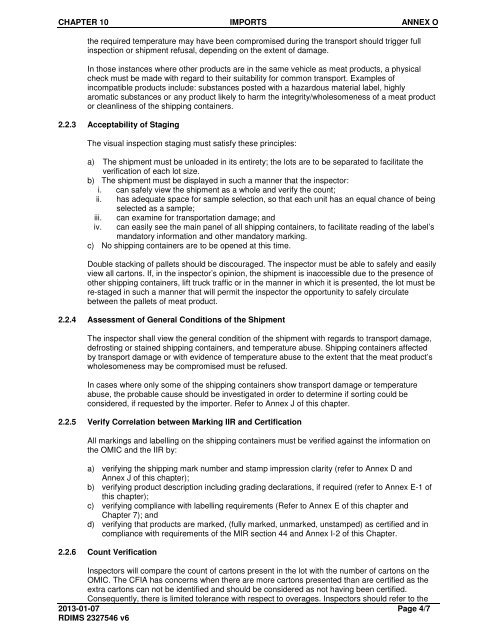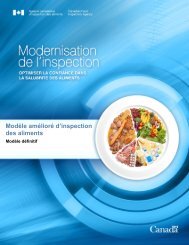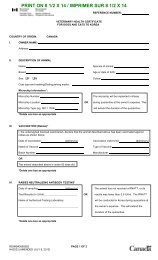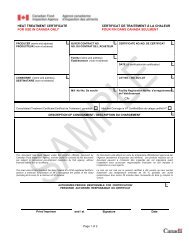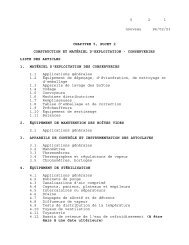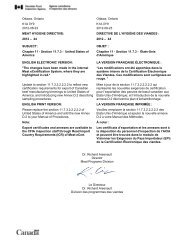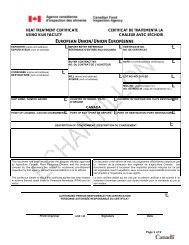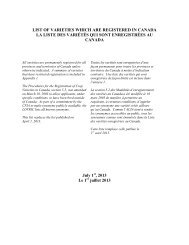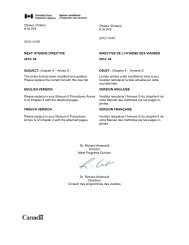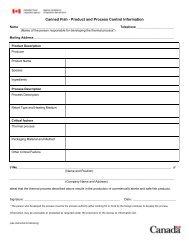PDF (342 kb ) - Agence canadienne d'inspection des aliments
PDF (342 kb ) - Agence canadienne d'inspection des aliments
PDF (342 kb ) - Agence canadienne d'inspection des aliments
Create successful ePaper yourself
Turn your PDF publications into a flip-book with our unique Google optimized e-Paper software.
CHAPTER 10 IMPORTS ANNEX Othe required temperature may have been compromised during the transport should trigger fullinspection or shipment refusal, depending on the extent of damage.In those instances where other products are in the same vehicle as meat products, a physicalcheck must be made with regard to their suitability for common transport. Examples ofincompatible products include: substances posted with a hazardous material label, highlyaromatic substances or any product likely to harm the integrity/wholesomeness of a meat productor cleanliness of the shipping containers.2.2.3 Acceptability of StagingThe visual inspection staging must satisfy these principles:a) The shipment must be unloaded in its entirety; the lots are to be separated to facilitate theverification of each lot size.b) The shipment must be displayed in such a manner that the inspector:i. can safely view the shipment as a whole and verify the count;ii. has adequate space for sample selection, so that each unit has an equal chance of beingselected as a sample;iii. can examine for transportation damage; andiv. can easily see the main panel of all shipping containers, to facilitate reading of the label’smandatory information and other mandatory marking.c) No shipping containers are to be opened at this time.Double stacking of pallets should be discouraged. The inspector must be able to safely and easilyview all cartons. If, in the inspector’s opinion, the shipment is inaccessible due to the presence ofother shipping containers, lift truck traffic or in the manner in which it is presented, the lot must bere-staged in such a manner that will permit the inspector the opportunity to safely circulatebetween the pallets of meat product.2.2.4 Assessment of General Conditions of the ShipmentThe inspector shall view the general condition of the shipment with regards to transport damage,defrosting or stained shipping containers, and temperature abuse. Shipping containers affectedby transport damage or with evidence of temperature abuse to the extent that the meat product’swholesomeness may be compromised must be refused.In cases where only some of the shipping containers show transport damage or temperatureabuse, the probable cause should be investigated in order to determine if sorting could beconsidered, if requested by the importer. Refer to Annex J of this chapter.2.2.5 Verify Correlation between Marking IIR and CertificationAll markings and labelling on the shipping containers must be verified against the information onthe OMIC and the IIR by:a) verifying the shipping mark number and stamp impression clarity (refer to Annex D andAnnex J of this chapter);b) verifying product <strong>des</strong>cription including grading declarations, if required (refer to Annex E-1 ofthis chapter);c) verifying compliance with labelling requirements (Refer to Annex E of this chapter andChapter 7); andd) verifying that products are marked, (fully marked, unmarked, unstamped) as certified and incompliance with requirements of the MIR section 44 and Annex I-2 of this Chapter.2.2.6 Count VerificationInspectors will compare the count of cartons present in the lot with the number of cartons on theOMIC. The CFIA has concerns when there are more cartons presented than are certified as theextra cartons can not be identified and should be considered as not having been certified.Consequently, there is limited tolerance with respect to overages. Inspectors should refer to the2013-01-07 Page 4/7RDIMS 2327546 v6


